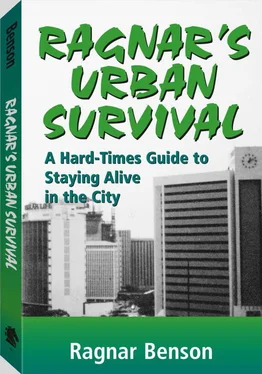After the tank has been buried into the side of a steep sloping hillside, it is difficult to tell that anything is there. Not only does a buried tank provide emergency shelter, it could also be used to store supplies. The total cost is less than $200, including using a backhoe for installation.
Not everyone can make use of this device, but at least by knowing the idea is out there, city survivors can make up their own minds.
A great many variations—often expensive—on this converted tank-shelter concept have been available. Several city survivors—mostly from the nuclear era—have installed one or two fiberglass septic tanks (linked by 36-inch-diameter pipe) in their backyards, in the floors of their garages, or in the front yard under the rose bushes. These shelters are certainly workable, but are expensive and a bit cramped. Details such as ventilation pipes and access holes must be attended to. Pipes sticking out of the ground can compromise the setup if poorly done.
Some large models of these almost-underground apartments are occasionally advertised in American Survival Guide. It’s likely that sales of these units are not particularly brisk, which explains why companies offering them seem to come and go rapidly.
It is possible, using cement blocks or even poured concrete, to wall up a corner of a basement, garage, warehouse, or even storage bin, providing a hidden shelter. During the past 20 years I have only seen a few. One was in Indonesia and another in Singapore. The last one was in Tarp, Germany, about 3 miles from the Danish border: this unit extended out under the fellow’s garden. The entrance was through a very narrow, cluttered cellar. The owner counted it as one of his life’s major accomplishments that he put this shelter in without local authorities approving or even knowing. His ventilation fan was cleverly hidden in a sort of German version of a gazebo.
They don’t tell you this in the instruction packet, but to be really successful, any shelters built into lower floors or the basement of existing buildings absolutely must include some sort of device to strengthen the roof above against collapse. Usually these are small steel I-beams or angle iron uprights and cross-members.
Another hideaway I looked at was accessible through an apartment complex and then through a warehouse. Originally this was a very small, now unused manager’s office blocked up inside a large warehouse. It seemed to me that this large, unused warehouse could have likely become a storage/repair facility for military vehicles during an emergency, but there was a well-stocked retreat there.
Another suggestion from early literature on the subject is to dig a trench in the ground over which an old vehicle is pulled. This is probably a holdover from the Cold War but it may work again. After moving the vehicle on top of the trench, its wheels are pulled off, marooning it over the chopped-out shelter hole.
Trench retreats probably should be lined with a plastic tarp. At best they have to be misery personified, but a great part of city survival is wanting very bad _y to survive. Can anyone today imagine living in a wet, dirty place like this? World War I soldiers in the trenches did, but they had a very strong pioneer spirit as well as tremendous will to make the best of it.
Of all these concepts, experts pick camping in old fire- and artillery-damaged or rubbleized buildings as being a second choice after just staying put in one’s nondescript, previously prepared retreat. Using tanks, tarps, dugouts, cement-block shelters, and so on are all workable. But many of these may not be feasible in your circumstances.
Two additional golden rules of survival round out plans for city survival. I’ve mentioned the first one before, but it bears repeating: Don’t allow others to set your destiny by causing you to become a refugee.
Second, do not get involved in any fighting raging around the retreat. Your contribution will be unmeasurable at best, while risks of drawing people and fire are great. The only exception is when the retreat is hopelessly compromised and it is time to take as many of the bastards along for the ride as possible.
These—and being willing and able to move the retreat at instant notice—are the golden rules of city survival shelters.
Chapter 9

Caching and Storage
As much or more so than any other class of survivor, city survivors should know the difference between caching and storage, as well as how to use these techniques to their advantage.
Storage is the laying in of items that may be essential for life at the retreat. Usually these are items of food and supplies that are not prima facie contraband and that, if lost, do not lead to a sudden and catastrophic deterioration of life. Caching is done for items that may be illegal and for which there is no substitute or other source of supply. You could say that storage is hiding and caching is deep hiding.
Of course, this can vary from culture to culture and situation to situation. Guns and ammunition are usually cached, whereas flour, dried peas, and salt are stored. How government officials view these various items determines whether they are cached or stored. Summary execution was the penalty in Nazi Germany for unauthorized possession of a firearm; in the Soviet-occupied Ukraine for unauthorized possession of food; and in medieval England for unauthorized possession of a Bible!
Caching has tactical and perhaps even strategic military significance. Incredibly, caching played a major role in the Battle for Europe, especially in France, Czechoslovakia, Italy, and Yugoslavia. Caching was also material in Vietnam. It may also eventually be a major factor for freedom in American society. While calling it a conspiracy may be premature, I often wonder why preparedness folks in general, and city survivors specifically, pay so little attention to the vital role of caching.
At the start of World War II in Europe, immediately after the fall of France, British military experts were looking for any help they could get. They searched for some tattered remnants of a group that could act as the nucleus of an insurgency unit. All they could initially discover were a very, very few members of a mostly dispirited Communist Party in France. The Communists were few because their own government had persecuted them before the German occupation and, of course, the Nazis had later ruthlessly hunted them down.
Mostly these Communists were located in Pans, but some were scattered throughout the provinces. Farmers often make ideal partisans, but our records suggest that few. if any, French farmers were Communists at that time.
Initially the British—and eventually the Americans, when they came into the fight—were reluctant to extend aid to Communists of any kind, no matter how worthy the cause. Many European Communists hadn’t wanted to fight the Nazis because of Hitler’s treaty with Stalin.
During all of 1941, England dropped only nine cache tubes containing weapons and explosives to French Communists. A British expert sent to Paris to gather information alleged two things: First, that French resistance fighters had altogether two ancient rifles and two pistols! All were hopelessly obsolete, and there were only a few rounds of ammo for each. In the case of the pistols, they were still black-powder rounds! Second, such as they were, these weapons were all in caches, the locations of which only a very few cell members knew. Active members at the time were almost all women. Any defections or admissions under torture could potentially collapse the entire movement.
Then it was June 22, 1941, and the German Operation Barbarossa against the Soviet Union was under way. At the same moment, additional war supplies from the United States were finally finding their way into the United Kingdom. In 1942, 201 containers of guns, ammunition, explosives, and medical supplies were air-dropped to the French Resistance. From ,January 1943 until the liberation of France on August 26, 1944, heaven’s gates were opened. Thousands of cache tubes were parachuted into France, Italy, and Czechoslovakia. And it worked. At. the end, the French Resistance alone was averaging one German soldier per day!
Читать дальше












